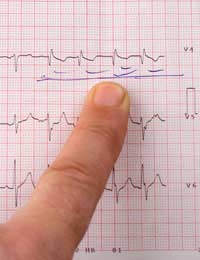Aortic Stenosis Treatments Available

Within the complex anatomy of the heart lies the aortic valve connecting the left ventricle of the heart to the main artery in the body the aorta. The aorta is a large artery responsible for supplying the rest of the body with its blood supply and feeds into most of the major arteries in the body.
When the ventricle contracts, this valve opens and blood is forced through. When the ventricle relaxes this valve closes and more blood fills the ventricle ready for the next contraction.
What is Aortic Stenosis?
Aortic stenosis occurs when this valve becomes narrowed and cannot open fully. If this happens the valve cannot function effectively, and the blood being pushed through the valve becomes restricted.This condition can develop into a serious illness, causing a large amount of discomfort and distress to the patient.
Signs and Symptoms
If this type of valve disease is in its early stages, there may be no evident symptoms, but as it progresses, the person may feel tiredness, dizziness, palpitations and occasionally chest pain. As the valve becomes narrowed, the heart compensates by working harder to push the blood through. Symptoms arise as the body and tissues become depleted of oxygen. Chest pain may occur if the arteries that supply the blood and oxygen to the heart muscles (the coronary arteries), do not receive the amount of oxygen that they require.If the condition is severe, it is possible that heart failure can occur and fluids can accumulate around the heart and lungs and in the tissues of the body.
What Causes Aortic Stenosis?
Most specialists agree that the main cause of aortic stenosis is due to age. Over time, it is thought that the valve becomes thickened and stiff, possibly due to an accumulation of calcium residue causing the valve to become unable to close properly.Other causes include rheumatic fever in childhood, because of congenital abnormalities or as a result of inflammatory conditions of the heart such as endocarditis.
Treatment Options
In some cases medication may be the best option, especially for those suffering from the symptoms of heart failure, and drugs such as diuretics (water tablets) and those that are designed to reduce the workload of the heart.For many, surgery may be the best option and procedures that may be suggested include the use of balloons to help dilate the valve opening, allowing it open better, or to repair or replace the valve entirely. Often the damage can be reduced and the original valve saved, but occasionally the use of a prosthetic device may be required.
Aortic stenosis can be a very serious condition that will need treatments to either minimise the damage, prevent it from developing further or to ease symptoms. Many people may have a small degree of stenosis without suffering from any symptoms, so as soon as any symptoms are experienced advice from your GP is recommended as the disease may have existed for some time. Treatment options vary depending on the patient and the severity of the condition and surgical options increasingly show good results for the patients.
- What is Ventricular Fibrillation?
- Stable and Unstable Angina: What's the Difference?
- What is Acute Coronary Syndrome (ACS)
- Why is High Blood Pressure Bad for the Heart?
- How Anorexia Affects the Heart
- What is Heart Failure?
- Preventing Cardiac Death in Young Athletes
- Are You at Risk of Heart Disease?
- An Enlarged Heart
- Hole in the Heart
- Pericarditis, Inflamation of the Pericardium
- Atherosclerosis, Hardening of the Arteries
- Heart Condition Dextrocardia Explained
- Why Do Palpitations Occur?
- Causes of Peripheral Artery Disease
- What is Atrial Myxoma?
- What is Cardiogenic Shock?
- Vitamin D & Heart Disease
- Wolffe-Parkinson-White Syndrome
- What Are Heart Murmurs?
- Rheumatic Heart Disease
- What is Myocardial Infarction?
- Mitral Valve Stenosis
- What is Bundle Branch Block?
- Heart Valve Disease
- Explaining Heart Disease
- What is Supraventricular Tachycardia?
- Aneurysm Causes & Treatments
- Congenital Heart Disease Explained
- What is Pericarditis?
- Suffering From Endocarditis
- Palpitations Explained
- What is Heart Block?
- What is Atrial Fibrillation?
- Angina Symptoms & Treatment


Re: Laser Surgery for Coronary Artery Disease
I was diagnosed with Idiopathic Pulmonary Fibrosis (IPF) four years ago. For over two years, I relied on…
Re: Coronary Angioplasty Surgery
My husband had a stent put in at the beginning of January. It was done at a government hospital and the doctors appointment is…
Re: Hole in the Heart: What Happens Next?
I was just in hospital with left side pain and numbness was diagnosed with hole in heart I’m home now and I’m having…
Re: Hole in the Heart: What Happens Next?
Ok I'm 61 yes old.ive been in 3 motorcycle wrecks,I have sticky platelets I've been hospitalized 3:times with blood…
Re: Why Does My Heart Beat Faster After Sweet Food?
The coffee doesn't make a heart beat faster. Caffeine makes the hart beat harder/stronger. The sugar…
Re: Hole in the Heart: What Happens Next?
Hi Doctor, My friend is having 35 years and he is having a hole in the heart, he consulted many doctors in USA and…
Re: What is Heart Block?
Hello. I have born first degree heart block. 10 years ago was temporarily changing to 2 degrees, but stay first degree. Am I at high risk…
Re: Hole in the Heart: What Happens Next?
In Sept '16 I was diagnosed with hypertension (high blood pressure) and in May '17 I had a stroke - the only symptoms…
Re: Hole in the Heart: What Happens Next?
Hi Iam 53 years old and living very healthy life. I have blood pressure but it is in normal condition with proper…
Re: What is Heart Block?
Hi there I had a pacemaker fitted last year for Mobitz II heart block. My pacemaker is set to fire if my rate drops below 60 b/pm. Am I…